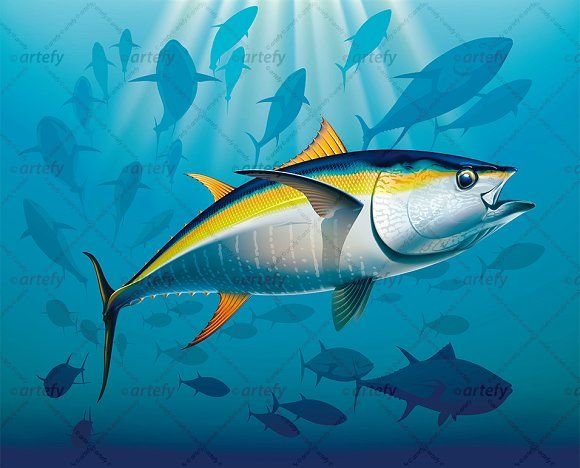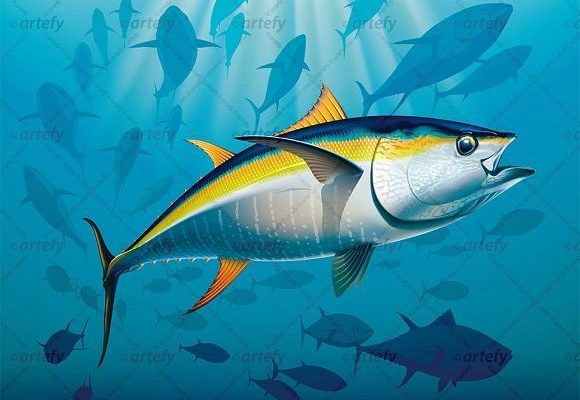
Think of the ocean as a bustling city with roads, highways, and neighborhoods. Just like we rely on signs, GPS, and even our friends to get around, the yellowfin tuna has its unique ways of finding its path and chatting with its pals. Understanding these methods not only reveals the tuna’s instincts but also sheds light on the fascinating world of marine life. Let’s dive in and explore the navigational skills and communication techniques of this incredible fish.
The Basics of Tuna Navigation
Yellowfin tuna are truly impressive navigators. They rely on a mixture of instinct and sensory abilities to find their way. Picture yourself walking through a new city—you might use landmarks, maps, or even the sun’s position to help you out. Similarly, yellowfin tuna use environmental cues to navigate the ocean.
One of the primary ways tuna find their way is through the Earth’s magnetic field. They possess specialized cells that can detect magnetic fields, like a natural GPS system. This ability allows them to migrate long distances and find their spawning grounds, sometimes traveling thousands of miles. It’s as if they have a built-in compass guiding them through the depths of the ocean.
Another fascinating aspect of their navigation is their ability to sense water temperature, salinity, and even currents. Just like how you’d choose a specific route based on traffic conditions, yellowfin tuna can adjust their path based on these underwater variables. They often follow specific currents or water temperatures, which can lead them to schools of prey or safe spawning areas.
How Tuna Use Sight for Navigation
Sight plays a crucial role in the yellowfin tuna’s navigation. Their large, well-adapted eyes allow them to see well in various light conditions, which is especially important in the twilight zones of the ocean. Imagine driving your car on a dark road; bright headlights make all the difference. For tuna, their ability to detect light helps them spot prey and avoid predators.
Moreover, they have a unique adaptation called a tapetum lucidum. This layer of tissue behind the retina enhances their eyesight in low light conditions, making it easier to see and react in the deep ocean. This adaptation is similar to how some animals have reflective eyes that shine in the dark. It gives yellowfin tuna a significant advantage, allowing them to navigate through murky waters or during dawn and dusk when many fish are active.
You might be wondering how they manage to avoid collisions while darting through schools of fish or coral reefs. Their excellent vision allows them to make quick decisions, helping them steer clear of obstacles. It’s a bit like how you’d quickly dodge an unexpected object while walking in a crowded place.
Sound and Vibration as Communication Tools
When it comes to communication, yellowfin tuna rely on more than just body language. They use sound and vibration to communicate with each other. This ability is akin to how people might communicate across a noisy room by yelling or using gestures. Tuna can produce sounds through specialized muscles near their swim bladders, which can convey messages such as mating calls or warnings to other fish.
These sound signals can travel long distances underwater, making it easier for them to stay in touch with their school. This form of communication is especially important during mating season when they need to find suitable partners among the vast ocean. Imagine a nightclub where the bass draws people together—tuna use sound waves to attract the attention of potential mates.
Additionally, the vibrations created by movement can also serve as a form of communication. When yellowfin tuna swim in groups, the water disturbances can signal information to nearby fish, helping them coordinate their movements. It’s a bit like how a group of friends might use a shared signal to decide when to cross the street together.
Body Language and Social Interactions
Yellowfin tuna also engage in body language to communicate with each other. When they’re swimming in schools, their movements can send powerful signals. For instance, rapid changes in direction or speed can indicate excitement, danger, or the presence of food. It’s much like the way dogs wag their tails or arch their backs to express feelings.
In social settings, such as when schools of tuna gather, they might display behaviors that signal their intentions or status. Dominant fish may show off by swimming energetically or changing colors slightly, much like how we might dress up or act a little differently in social situations to impress others.
This is important not just for social interactions but also for maintaining order within the school. By signaling their intentions clearly, tuna can reduce conflicts and ensure that the group moves cohesively through their watery environment. Picture a well-rehearsed dance routine where everyone knows their steps—that’s how these tuna navigate their social structures!
Challenges in Navigation and Communication
While yellowfin tuna have developed impressive skills for navigating and communicating, they face various challenges in the ocean. Environmental changes, such as temperature fluctuations or pollution, can disrupt their natural navigation systems. If you think about how a thunderstorm might affect your GPS signal, the same concept applies to tuna. Changes in ocean currents or water conditions can confuse their senses, making it harder for them to find food or safe breeding grounds.
Moreover, human activities pose significant threats to their communication and navigation. Overfishing and habitat destruction can reduce their populations and disrupt schools, making it harder for them to find mates or coordinate movements. It’s like trying to catch up with friends in a crowded venue; if friends are scattered, it’s challenging to stay connected.
To add to this, noise pollution from ships, sonar, and other maritime activities can interfere with their ability to hear sounds and communicate. Imagine shouting to a friend at a concert—if it’s too loud, it becomes nearly impossible to be heard. For yellowfin tuna, this can mean miscommunication and an inability to respond to threats or opportunities effectively.
Conservation and the Future of Yellowfin Tuna Navigation
Given the challenges facing yellowfin tuna, conservation efforts are essential for the future of their navigation and communication. Sustainable fishing practices are critical to ensuring that these magnificent fish continue to thrive in their natural habitats. Just like how we might support local businesses to keep our communities strong, supporting sustainable seafood initiatives helps protect tuna populations.
Scientists are also researching ways to better understand how yellowfin tuna navigate and communicate. By studying their behaviors and adapting conservation strategies accordingly, we can create a healthier ocean environment. It’s like setting up a strong foundation for a house—if the base is solid, everything else can thrive on top.
Public awareness and education play crucial roles in conservation efforts. By sharing knowledge about these incredible fish and their unique skills, we can inspire others to appreciate and protect them. Just imagine if everyone knew how vital these fish are to ocean ecosystems; collective action could lead to significant changes.
In conclusion, the yellowfin tuna is not just a remarkable fish; it’s a master navigator and communicator in the ocean. By understanding how these tuna find their way and connect with each other, we can appreciate the intricacies of marine life. As we work together to conserve their habitats and promote sustainable practices, we ensure that future generations can marvel at the beauty of these amazing creatures.

